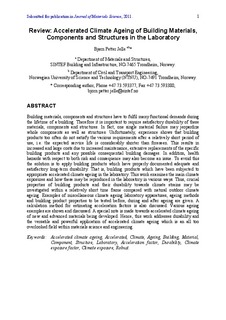| dc.description.abstract | Building materials, components and structures have to fulfil many functional demands during the lifetime of a building. Therefore, it is important to require satisfactory durability of these materials, components and structures. In fact, one single material failure may jeopardize whole components as well as structures. Unfortunately, experience shows that building products too often do not satisfy the various requirements after a relatively short period of use, i.e. the expected service life is considerably shorter than foreseen. This results in increased and large costs due to increased maintenance, extensive replacements of the specific building products and any possible consequential building damages. In addition, health hazards with respect to both risk and consequence may also become an issue. To avoid this, the solution is to apply building products which have properly documented adequate and satisfactory long-term durability. That is, building products which have been subjected to long-term natural outdoor climate exposure or appropriate accelerated climate ageing in the laboratory. This study examines the main climate exposures and how these may be reproduced in the laboratory in various ways. Thus, crucial properties of building products and their durability towards climate strains may be investigated within a relatively short time frame compared with natural outdoor climate ageing. Examples of miscellaneous climate ageing laboratory apparatuses, ageing methods and building product properties to be tested before, during and after ageing are given. A calculation method for estimating acceleration factors is also discussed. Various ageing examples are shown and discussed. A special note is made towards accelerated climate ageing of new and advanced materials being developed. Hence, this study addresses durability and the versatile and powerful application of accelerated climate ageing which is an all too overlooked field within materials science and engineering | |

